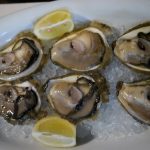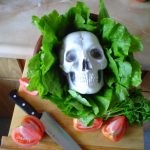50 years of pucks to the head, 4 years as a linebacker in football (gridiron) the car crash, the bike falls and so many others.
Author Archives: Douglas Powell
Tony O in Chicago with bro Phil and CTE
Tony’s still wearing the same shitty equipment I was wearing playing pick-up in Guelph in the early 2000s.
 And that mask. I try to describe what goalie masks were like when I started playing in 1967, and the best description I can come up with is, they were plastic Halloween masks; at least Tony’s had some wire on it.
And that mask. I try to describe what goalie masks were like when I started playing in 1967, and the best description I can come up with is, they were plastic Halloween masks; at least Tony’s had some wire on it.
He also used to cover his body in Vaseline so the pucks would hurt less.
He still holds the record for single season shutouts, set in 1970.
I have an autographed picture of Tony tucked away somewhere.
Not bad for a couple of boys from the Sault (Ste. Marie).
 Tony’s taken a lot of pucks to the head; so have I.
Tony’s taken a lot of pucks to the head; so have I.
Tony seems fine, me not so much.
Today I (almost) finalized the paperwork to donate my brain to the Sports Brain Bank in Sydney upon my death. They’re affiliated with the U.S. branch and do research on chronic traumatic encephalopathy (see the movie Concussion). They’ve asked us to post a picture with our brain donor card.
Awareness of concussions and how special our brains are has come a long way since 1967, but there is still much that is unknown.
#MyLegacyPledge
dougsdeadflowers.com: Roses by your grave
I’m an ideas guy, not a details guy, but Amy sorted it out and things are now at dougsdeadflowers.com.
 I started this post two days ago and forgot what I was writing about.
I started this post two days ago and forgot what I was writing about.
Brain.
When I was a kid, our family would drive every other weekend two hours north to Cookstown, Ontario (that’s in Canada).
I usually barfed and still do today.
I have lots of memories of me and gramps driving from Cookstown to Toronto to get parts for his Massey-Ferguson dealership, but I can feel those memories fading away, every time I have to pause and rethink what I was writing.
Missouri is a special place: Rent-A-Car Employee accused of spiking co-workers’ water with LSD
I did acid twice, in my teens.
Mushrooms are a much better psychedelic, but I only did them once.,
I had a colleague in the early 1990s who would tell me when he retired, he would sit at a cottage with a couple of Marshall amps, his electric guitar and do a bunch of hallucinogens.
Not sure that worked out.
According to Tom Ozimek of The Epoch Times, authorities are investigating the case of an Enterprise Rent-A-Car employee accused of slipping LSD into his co-workers’ water bottles.
A 19-year-old man is in custody in connection with the incident, which allegedly took place at an Enterprise Rent-A-Car location in Arnold, Missouri, last Thursday, March 21, according to KMOV.
Arnold Police received a call from the Enterprise manager, who reported that two employees, a 24-year-old woman and a 23-year-old man, had both been hospitalized after they began to feel “weird and dizzy,” according to the Jefferson County Leader.
Police say the man told them his coworkers at Enterprise Rent-A-Car had “negative energy,” and he wanted them to mellow out. So the 19-year-old put LSD in three people’s water bottles and coffee cups.
Messing around with people’s food or beverages is never OK.
Croatia’s prime oyster farmers in alarm after norovirus discovered
I’m not sure who decided raw oysters were a food, because that gelatinous slime is gross.
 Oysters are also vulnerable to norovirus.
Oysters are also vulnerable to norovirus.
Authorities have detected norovirus, which causes diarrhea and vomiting, in parts of the Mali Ston bay in Croatia—triggering shock and alarm among the breeders.
The traditional oyster-tasting feast in March has been canceled and fears are mounting of huge financial losses to the local community that harvests about 3 million oysters each year.
Experts are pointing their fingers at the outdated sewage system in the area that has seen a rise in the numbers of tourists flocking to Croatia’s stunning Adriatic coast.
“I am really sorry but people themselves are to blame that something like this happened,” explained Vlado Onofri from the Institute for Marine and Coastal Research in nearby Dubrovnik. “It’s something that has to be solved in the future.”
While some stomach bugs can be eliminated with cooking, norovirus survives at relatively high temperatures.
Navigating the oyster fields in their small boats, the farmers proudly show visitors rows and rows of oyster-filled underwater farm beds spreading through the bay.
Top municipal official Vedran Antunica questioned the assumption that the local sewage system was to blame for the outbreak.
“Viruses are everywhere, now as we speak, the air is full of viruses,” Antunica said. “We had the same sewage system in the past, so why wasn’t it (norovirus) recorded? What has changed?”
Some would call it knowledge.
And we’re all hosts on a viral planet.
Raw is risky: Noro sickens 180 at UK hospital because someone thought bringing raw mussels in was a good idea
This story is from Dec. 2017, but instructive.
 Do not bring raw anything into a hospital full of immunocompromised people (those NZ mussels are cooked).
Do not bring raw anything into a hospital full of immunocompromised people (those NZ mussels are cooked).
And I’m still looking at you, Brisbane Private Hospital, for continuing to serve raw sprouts on everything.
The Bailiwick Express reports that an outbreak of the winter vomiting bug (we call it Norovirus) which forced hospital bosses to ban visitors from wards was caused by someone bringing mussels in for a patient, it has emerged.
Over Christmas, Northumbria Healthcare NHS Trust will partially lift the restriction on visitors, introduced after norovirus spread across a number of sites.
Officials have traced its spread to a visitor bringing in mussels for an inpatient at Wansbeck General Hospital in Ashington, Northumberland.
It is thought to have affected at least 180 people.
Shellfish can harbour the norovirus infection.
3 dead, 92 hospitalized, 555 sick from raw chicken thingies in Canada
In 2005, after Chapman was afraid he’d be eaten by bears in Prince George, BC (that’s in Canada) we met with Phebus at a pub in beautiful Manhattan, Kansas, and crafted a research project idea to see how people actually cooked raw chicken thingies (maybe it was 2006, my memory is shit).
 The American Meat Institute funded it, we wrote a paper (which was not our best writing), but seems sort of apt now that 555 Canadians have been laboratory confirmed with Salmonella from raw frozen chicken thingies.
The American Meat Institute funded it, we wrote a paper (which was not our best writing), but seems sort of apt now that 555 Canadians have been laboratory confirmed with Salmonella from raw frozen chicken thingies.
Jordyn Posluns of Narcity reports:
The Public Health Agency of Canada indicated that of those affected by the salmonella outbreaks, 92 individuals were hospitalized. Three people have also died in connection to the outbreaks.
Like many infections, salmonella doesn’t discriminate those infected by the contaminated chicken products were Canadians of a wide range of ages and of different genders.
Direct video observation of adults and tweens cooking raw frozen chicken thingies
01.nov.09
British Food Journal, Vol 111, Issue 9, p 915-929
Sarah DeDonder, Casey J. Jacob, Brae V. Surgeoner, Benjamin Chapman, Randall Phebus, Douglas A. Powell
The purpose of the present study was to observe the preparation practices of both adult and young consumers using frozen, uncooked, breaded chicken products, which were previously involved in outbreaks linked to consumer mishandling. The study also sought to observe behaviors of adolescents as home food preparers. Finally, the study aimed to compare food handler behaviors with those prescribed on product labels.
Design/methodology/approach – The study sought, through video observation and self-report surveys, to determine if differences exist between consumers’ intent and actual behavior.
Findings – A survey study of consumer reactions to safe food-handling labels on raw meat and poultry products suggested that instructions for safe handling found on labels had only limited influence on consumer practices. The labels studied by these researchers were found on the packaging of chicken products examined in the current study alongside step-by-step cooking instructions. Observational techniques, as mentioned above, provide a different perception of consumer behaviors. Originality/value – This paper finds areas that have not been studied in previous observational research and is an excellent addition to existing literature.
Dumbing down: Mark Bittman is starting a food magazine at Medium
Mark Bittman is a food safety idiot.
 This is nothing new, he’s been publishing his microbiological rubbish about the glories of eating raw hamburger, not using a thermometer and other shit for decades and that someone would give him a new gig is baffling.
This is nothing new, he’s been publishing his microbiological rubbish about the glories of eating raw hamburger, not using a thermometer and other shit for decades and that someone would give him a new gig is baffling.
He’ll now head up a new online magazine, Salty.
Nice title. My kidneys can’t handle that.
“We’re doing practical stories that will help people see food in a way they haven’t seen it before,” said Bittman.
If I was going to reinvent myself, this would be the least creative way to go.
Salty, which is making its debut on Tuesday, will comprise recipes, stories related to food and more.
From the duh files: How well do you understand irrigation water risk management?
Doug Grant of The Packer writes food safety outbreaks have a massive effect not only on growers, but on all stakeholders throughout the fresh produce supply chain. Irrigation water has been identified over the years as a likely cause of fresh produce contamination, so it’s critical that our industry fully understands the potential risk involved and how these risks are being managed by growers.The Center for Produce Safety has numerous research projects involving irrigation water. One 2015 project titled “Evaluation of risk-based water quality sampling strategies for the fresh produce industry,” led by PI Channah Rock, Ph.D., University of Arizona, concluded that “localized environmental conditions play a large role in water quality.”
 Further, that “growers must get a better understanding of their water sources through collection of water quality data and historical analysis.” Another outcome from this project was developing a computer app to provide guidance on the frequency of sampling based on risk factors (e.g. after rainfall).
Further, that “growers must get a better understanding of their water sources through collection of water quality data and historical analysis.” Another outcome from this project was developing a computer app to provide guidance on the frequency of sampling based on risk factors (e.g. after rainfall).
Several other CPS research projects focus on predictive models for irrigation water quality, exploring the relationship between product testing and risk, reuse of tail water and evaluating alternative irrigation water quality indicators.
Let me introduce Natalie Dyenson, head of food safety and quality assurance at Dole. As you can imagine, she has a huge responsibility covering several product lines (fruits, vegetables, leafy greens and packaged salads) sourced from hundreds of growers throughout the Americas and other countries. She’s been involved with CPS for several years and takes a keen interest in new research findings.
With leafy greens as her top priority, she is still very concerned about the three romaine lettuce outbreaks during 2018. With all Dole crops, water quality risk assessment and testing are very important. Dole reviews water source (wells, reservoir, canals, etc.) and type of irrigation (foliar spray, furrow irrigation, flooding farms).
All water sources including deep wells are tested monthly, and after weather events such as wind and frost. Enhanced testing of product is done prior to harvest depending on their environmental risk assessments — for example, after an excessive rain event where potential contaminated water run-off could be introduced to the field.
Natalie said, “there is a huge potential to leverage historical water quality test data to help mitigate risk.” She’s also very interested in predictive models and is looking forward to the results of a CPS research project starting in 2019, “Development of a model to predict the impact of sediments on microbial irrigation water quality,” led by Charles P. Gerba, Ph.D, from the University of Arizona.
Previous CPS research has shown that sediments at the bottom of waterways can harbor 10 to 10,000 more fecal bacteria than surface waters. This new project will investigate the conditions where pathogens could be re-suspended in surface water and will design sampling strategies to minimize contamination to crops.
While discussing sediment in irrigation canals Natalie mentioned that it’s been observed that some non-Dole farmers are still laying irrigation intake hoses directly on the bottom of water sources (canals, ponds, etc.). A simple solution is to use a flotation device positioned so that the hose end extracts water just below the surface where there are fewer potential contaminants. While not a complete remedy to eliminate all organic matter and pathogens in the water supply, it is a simple tool to help reduce risk.
Falling down
First I started falling on my hockey skates and the was the end of my 50-year hockey career.
 Then I fell off my bike a couple of times and that was the end of cyclying.
Then I fell off my bike a couple of times and that was the end of cyclying.
Then I started falling while walking.
My wife thinks I’m a drunk, I think I’ve taken too many pucks to the head as a goaltender in ice hockey since 1967 (the last time the Leafs won the cup), 4 years as a linebacker in North American football, the car crash and everything else.
Amy took me to emergency yesterday a.m. because she’s solid like that.
Three stiches in the ear, a couple in my forehead.
Yes, it fucking hurt.
FML.
Check out my new web site,dougsdeadflowers.com.


